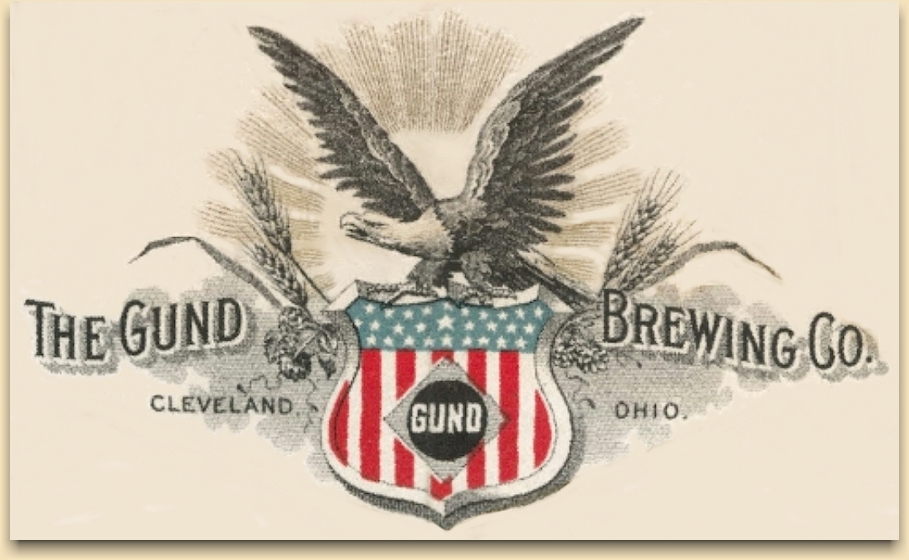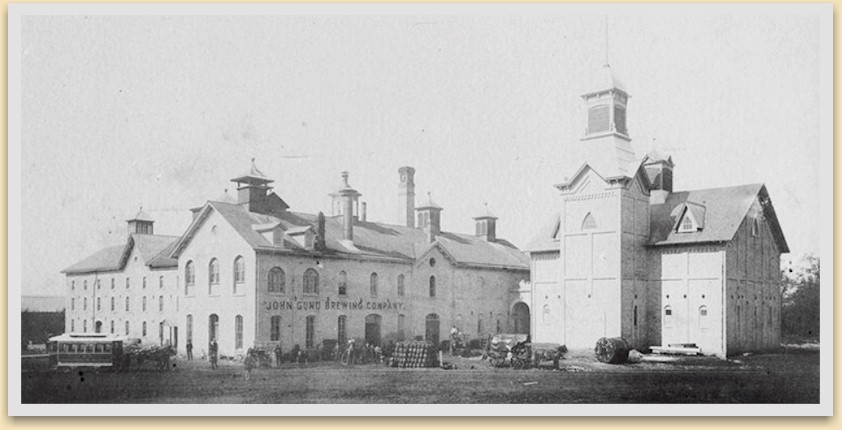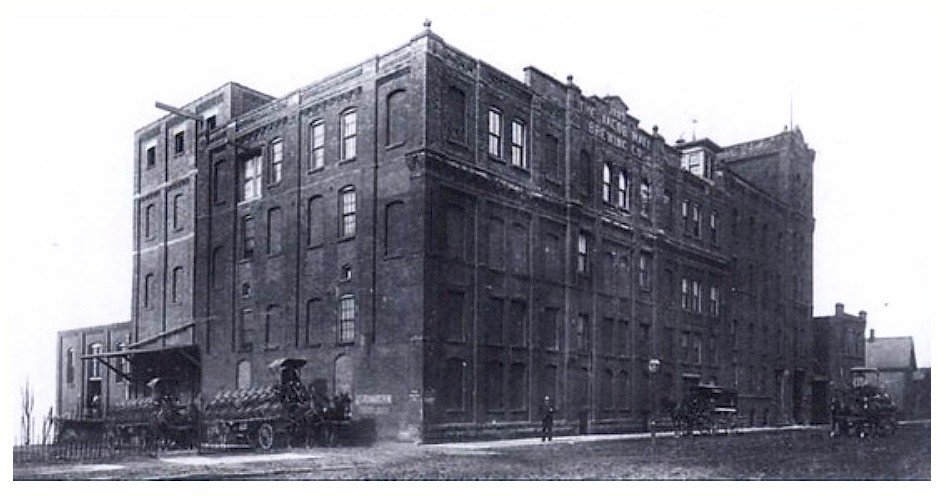BREWERY GEMS PROFILES:
George F. Gund - Brewer
![]()

Biography of George Frederick Gund
(1855 -1916)
This biography
is a compilation of early newspaper accounts, city directory listings, and regional
histories.
George Gund is best remembered as a successful Cleveland brewer who established the Gund Brewing Co. in 1900.
Yet, little is written of his years prior to his arrival in Cleveland. George Frederick Gund was
born at La Crosse, Wisconsin, April 5, 1855. He was the son of John Gund and
Louise Hottman Gund, both natives of Germany. George had two brothers and two
sisters. Brothers, Henry and John, as well as one brother-in-law, worked in the
family's brewery. George received his education in the public schools
of his native city. At the age of fifteen, he entered the employ of the Batavian Bank, remaining with
that institution for six years, or until July 1, 1876. He was then employed by his father
in the brewing business, which was incorporated in 1880 as the John Gund Brewing Company.
Upon incorporation of this company, he served as secretary and treasurer. This
was the largest brewery in Wisconsin, outside of Milwaukee.
George was married to Anna Louise Metzger, on 14 March 1886, and this
union produced two children, George, Jr., and Agnes.
George left LaCrosse for the West Coast with his family in December of 1890. He didn't
advertise his purpose, but he had been observing both English and U.S.
syndicates buying up breweries, and getting rich through higher returns
on investment, and through restructuring these combines. Now he was
hoping to do the same.
Upon his arrival in Washington State, George did a newspaper interview for
the Seattle Post-Intellegencer, which was published on 30 December. He said that La
Crosse was a "rather slow city" so he decided to come here and "what I
shall do, I cannot tell." He then went on to discuss the buying of
American breweries by English syndicates, suggesting that the practice
is on the decline.
Five months later he accomplished phase one of what he had been planning to do. In May of '91, he purchased 50% of the Claussen-Sweeney brewery and bottling
works¹ from Hans
Claussen.
Then three months later, phase two of his plan was revealed.
Then two days later this follow-up story appeared: While the proposed combine members failed to come
to an aggreement, the revealed plan was obviously a leak, and not a
rumor. What was true, was that Gund did not purchase the Wegert brewery²,
nor attempt to.
The newspaper article should have called it Wegert's brewery, or the The
North Pacific Brewery. The proposed combine didn't materialize, but for
George, it remained an objective, and a year and a half later he
succeeded. On 11 January, 1893,
the Bay View brewery joined with the breweries of
Albert Braun and
Claussen-Sweeney to form a new association - the
Seattle Brewing & Malting Company.
George was the main architect of this merger, but he had an accomplice
in Otto Huber, who was head of a group of Eastern investors behind the
Albert Braun Brewing Association.
As usually happens with these consolidations, the least viable unit is
closed. In this case, the executive board voted to shut down the Albert
Braun Brewing Associaton's beer production, while continuing with the
ice production. The board also voted to send vice-president, Albert
Braun, to San Francisco to oversee SB&M's California business. As a
result of his brewery's shuttering, and his posting to SF, Albert
resigned from SB&M, and left Seattle.
In January 1896, George was voted president of SB&M, with his
brother-in-law, Alfred F. Metzger, as secretary. Fourteen months later,
on 21 March 1897, George resigned his position and sold his shares to
Andrew and Louis Hemrich. He then departed for Cleveland, having
purchased the Jacob Mall Brewing Company.
He continued operating it as the Jacob Mall brewery for almost three
years. Then, in 1900, he incorporated the company and renamed
it the Gund Brewing Co. An entrepreneur in the truest sense of the
word, he used money generated by the brewery to invest in other
ventures, such as mining companies, realty, and banking.
Having started in banking, in La Crosse, it was fitting that he sat
on the boards of two banks in Seattle, and was associated with two in
Cleveland as well. George F. Gund built himself a financial empire, but
unfortunately, he died at the early age of 60, in 1916.
FOOTNOTES:
¹
As co-owner of the Claussen-Sweeney bottling works, Gund offered the
position of manager to a family friend from La Crosse,
John G. Fox.
Article by
Copyright © 2024 by BreweryGems
~ All Rights Reserved.


On 9 August 1891, theSeattle
Post-Intellegencer ran this story: "Seattle is now the headquarters
great brewery trust, which includes all the breweries of this city and
Tacoma. Within a month the arrangements will have been perfected and the
consolidated company will take charge of the business of all the
companies.
The consolidation has been brought about by George Gund,
formerly of La Crosse, Wis. He began by buying the interest of Hans
Claussen in the Claussen-Sweeney brewery, and purchased outright the
Wegert brewery in this city. A further step in the direction of
consolidation was made yesterday when the Puget Sound Brewing Company,
of Tacoma, bought a three-fourths interest in the Donau brewery, of that
city, at sheriff's sale. The United States brewery, of Tacoma, was also
bought up. All the breweries in the two cities - the Braun, Bay View,
Claussen-Sweeney and Wegert, in Seattle, and the Puget Sound, Donau and
United States, in Tacoma - have been placed under heavy bonds
preparatory to consolidation under the management of one corporation,
which will be organized by September.
The new company will be called
the United Puget Sound Breweries, and will have a capital stock of
$2,000,000. Its main office will be in Seattle, and its president will
be either Mr. Gund or Mr. Sweeney. The Braun brewery will be used
entirely to supply the export trade, the Bay View will supply malt to
all the breweries, and supply beer to Seattle alone, and the Puget Sound
brewery will supply the Tacoma local trade. The Claussen-Sweeney
brewery, of Seattle, and the Donau brewery, of Tacoma, will be closed,
while the other breweries will be operated to their full capacity, and
supply the whole trade, both home and export.
On behalf of the
consolidation it is claimed that it will bring about economy in
management and production, and put an end to ruinous competition.
The capacity of the breweries of the Sound exceeds the demand, and
none of them have been running to their capacity."Mr. George Gund,
who was reported to be at the head of a combine of the brewers of Puget
Sound, said last night; "The only thing which can give color to the
rumor is the fact that Seattle and
Tacoma brewers have lately held several conferences to divide the
territory and fix prices if possible for outside business. The Tacoma
brewers think we ought not to go into Puyallup, and we, on the contrary,
want them to keep out of - well say Snohomish. So we have been trying to
divide the territory fairly between us.
"The Donau brewery, before it
was sold out by the sheriff, was cutting rates very sharply. The
management was desperate, and in order to get a little money beer was
sold for $5 a barrel, or, for that matter, at any price which would
bring in quick returns. This demoralized the business everywhere. So we
have been trying to put prices at a point which will give a fair profit.
There is no intention whatever of closing the Claussen-Sweeney brewery.
As for the Wegert brewery, which I am said to have bought, I have never
even visited it.”
²
In January of 1891, Julius Wegert sold
his
North Pacific Brewery to Lester Turner for $5,000 - the sale was not
made public. Turner was with the 1st National Bank of
Seattle, acting as agent for John Hemrich. Charles A.
Saake was then hired to manage the brewery,
which continued operating until late in '96,
when John's son, Alvin M. Hemrich, took possession of the plant and business
of the North Pacific Brewery.
For any comments, additions, or corrections please
contact me: